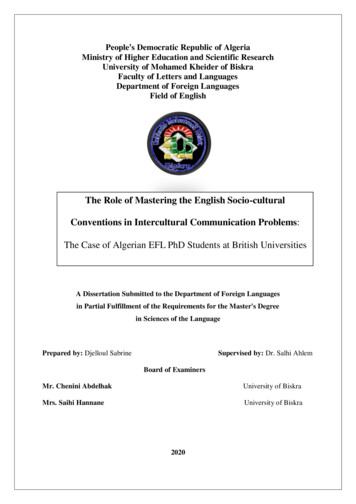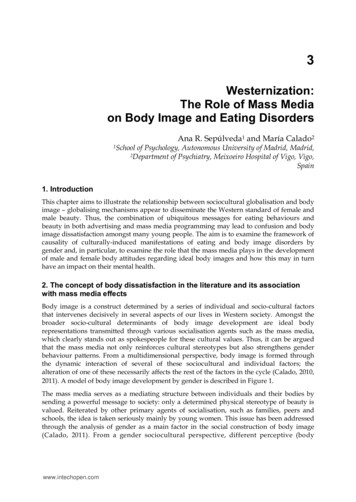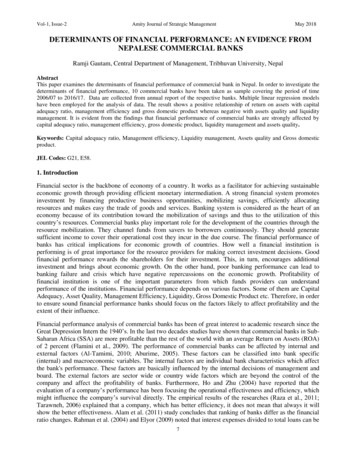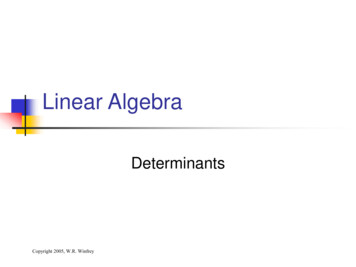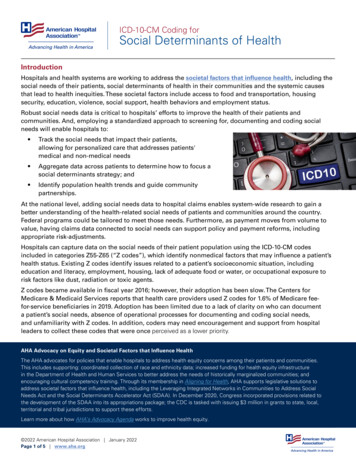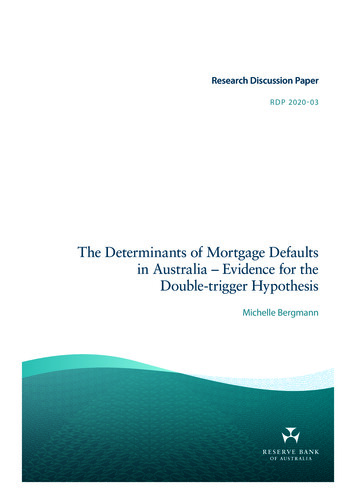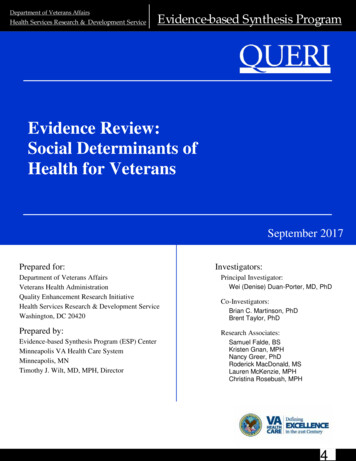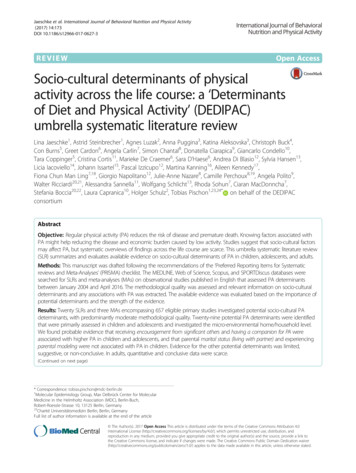
Transcription
Jaeschke et al. International Journal of Behavioral Nutrition and Physical Activity(2017) 14:173DOI 10.1186/s12966-017-0627-3REVIEWOpen AccessSocio-cultural determinants of physicalactivity across the life course: a ‘Determinantsof Diet and Physical Activity’ (DEDIPAC)umbrella systematic literature reviewLina Jaeschke1, Astrid Steinbrecher1, Agnes Luzak2, Anna Puggina3, Katina Aleksovska3, Christoph Buck4,Con Burns5, Greet Cardon6, Angela Carlin7, Simon Chantal8, Donatella Ciarapica9, Giancarlo Condello10,Tara Coppinger5, Cristina Cortis11, Marieke De Craemer6, Sara D’Haese6, Andrea Di Blasio12, Sylvia Hansen13,Licia Iacoviello14, Johann Issartel15, Pascal Izzicupo12, Martina Kanning16, Aileen Kennedy17,Fiona Chun Man Ling7,18, Giorgio Napolitano12, Julie-Anne Nazare8, Camille Perchoux8,19, Angela Polito9,Walter Ricciardi20,21, Alessandra Sannella11, Wolfgang Schlicht13, Rhoda Sohun7, Ciaran MacDonncha7,Stefania Boccia20,22, Laura Capranica10, Holger Schulz2, Tobias Pischon1,23,24* on behalf of the DEDIPACconsortiumAbstractObjective: Regular physical activity (PA) reduces the risk of disease and premature death. Knowing factors associated withPA might help reducing the disease and economic burden caused by low activity. Studies suggest that socio-cultural factorsmay affect PA, but systematic overviews of findings across the life course are scarce. This umbrella systematic literature review(SLR) summarizes and evaluates available evidence on socio-cultural determinants of PA in children, adolescents, and adults.Methods: This manuscript was drafted following the recommendations of the ‘Preferred Reporting Items for Systematicreviews and Meta-Analyses’ (PRISMA) checklist. The MEDLINE, Web of Science, Scopus, and SPORTDiscus databases weresearched for SLRs and meta-analyses (MAs) on observational studies published in English that assessed PA determinantsbetween January 2004 and April 2016. The methodological quality was assessed and relevant information on socio-culturaldeterminants and any associations with PA was extracted. The available evidence was evaluated based on the importance ofpotential determinants and the strength of the evidence.Results: Twenty SLRs and three MAs encompassing 657 eligible primary studies investigated potential socio-cultural PAdeterminants, with predominantly moderate methodological quality. Twenty-nine potential PA determinants were identifiedthat were primarily assessed in children and adolescents and investigated the micro-environmental home/household level.We found probable evidence that receiving encouragement from significant others and having a companion for PA wereassociated with higher PA in children and adolescents, and that parental marital status (living with partner) and experiencingparental modeling were not associated with PA in children. Evidence for the other potential determinants was limited,suggestive, or non-conclusive. In adults, quantitative and conclusive data were scarce.(Continued on next page)* Correspondence: tobias.pischon@mdc-berlin.de1Molecular Epidemiology Group, Max Delbrück Center for MolecularMedicine in the Helmholtz Association (MDC), Berlin-Buch,Robert-Roessle-Strasse 10, 13125 Berlin, Germany23Charité Universitätsmedizin Berlin, Berlin, GermanyFull list of author information is available at the end of the article The Author(s). 2017 Open Access This article is distributed under the terms of the Creative Commons Attribution 4.0International License (http://creativecommons.org/licenses/by/4.0/), which permits unrestricted use, distribution, andreproduction in any medium, provided you give appropriate credit to the original author(s) and the source, provide a link tothe Creative Commons license, and indicate if changes were made. The Creative Commons Public Domain Dedication o/1.0/) applies to the data made available in this article, unless otherwise stated.
Jaeschke et al. International Journal of Behavioral Nutrition and Physical Activity (2017) 14:173Page 2 of 15(Continued from previous page)Conclusions: A substantial number of SLRs and MAs investigating potential socio-cultural determinants of PA were identified.Our data suggest that receiving social support from significant others may increase PA levels in children and adolescents,whereas parental marital status is not a determinant in children. Evidence for other potential determinants was limited. Thiswas mainly due to inconsistencies in results on potential socio-cultural determinants of PA across reviews and studies.Trial registrations: This umbrella SLR was recorded on PROSPERO (Record ID: CRD42015010616).Keywords: Socio-cultural determinants, Physical activity, Life course, Children, Adolescents, Adults, Umbrella systematicliterature reviewBackgroundLack of physical activity (PA) is an established risk factorfor numerous chronic diseases and premature death,whereas regular PA reduces disease and mortality risk[1–3]. For adults (i.e., 18–64 years) and older adults(i.e., 65 years), the World Health Organization(WHO) recommends at least 150 min of moderate or75 min of vigorous PA per week to prevent noncommunicable diseases, while children and adolescentbetween 5 and 17 years should accumulate at least60 min of moderate-to-vigorous activity [2]. Nevertheless, 23% of adults globally, up to one third of European adults, and a vast majority of children and adolescentsin Europe and worldwide are not sufficiently active to meetthese recommendations [4–6]. Low PA accounts for a huge,but avoidable disease burden and is among the five leadingrisks for mortality in the world, responsible for 5.5% of deathsglobally [3, 7]. In addition, it is among the seven leading riskfactors for disability-adjusted life years (DALYs), responsiblefor 3.5% of DALYs in the WHO European Region [8].Research into determinants (causally related factors)and correlates (associated factors) of PA have increased inthe last decade, and several factors have been identified tobe purportedly related to PA, including socio-cultural factors [9–12]. Socio-cultural determinants of PA are definedas ‘community's or society's attitudes, beliefs, and valuesrelated to health behaviour’ that might have a ‘powerful effect on the behaviour of individual members of the community group’ [13]. However, systematic overviews onsocio-cultural determinants of PA are scarce and mainlyfocus on specific age ranges, neglecting the possibility toevaluate the impact of socio-cultural PA determinants indifferent age groups [9, 10].The aim of this umbrella systematic literature review(SLR) was to provide an overview, compilation, andevaluation of the available evidence from published SLRsand meta-analyses (MAs) of primary observational studies assessing socio-cultural determinants of PA in children, adolescents, and adults.Materials and methodsThe European Commission has initiated the ‘Joint Programming Initiative A Healthy Diet for a Healthy Life’aiming to enhance cooperation, to pool knowledge, andto engage in a common research agenda to finally promote healthy lifestyles across Europe [14]. As first act,the ‘DEterminants of DIet and Physical ACtivity (DEDIPAC) Knowledge Hub (KH)’ was launched in 2013 as amulti-disciplinary collaboration of experts, organizations, and consortia across 12 European countries [15].One of the aims of the DEDIPAC KH was to assess determinants of PA across the life course. The DEDIPACKH coordinated seven umbrella SLRs (i.e., reviews thatassemble together several systematic reviews on thesame condition [16]) on the evidence on biological, psychological, behavioural, physical, socio-cultural, economic, and policy determinants of PA [15]. Diet wasaddressed separately [17].The seven manuscripts were drafted following recommendations of the ‘Preferred Reporting Items for Systematic reviews and Meta-Analyses’ (PRISMA) checklist[18]. The protocol applied to all seven DEDIPAC umbrella SLRs was recorded on PROSPERO (Record ID:CRD42015010616), the international prospective registerof systematic reviews [19].Search strategy and eligibility criteriaTo identify eligible SLRs and MAs investigating determinants of PA in different age groups, a systematic onlinesearch limited to English publications was conducted inMEDLINE, Web of Science, Scopus, and SPORTDiscusdatabases. To avoid duplications of the earliest individual studies included in the SLRs and MAs, the searchwas limited to publications between January, 1st, 2004and April, 30th, 2016. The decision on the cut-off datewas made since the seven umbrella SLRs were initiatedin 2014 and the DEDIPAC KH aimed to encompass a10-years publication period [15]. In 2016, prior to finalizing the seven umbrella SLRs, the literature search wasupdated to also include publications in 2015 and 2016,and, thus, to encompass the lifetime of the DEDIPACproject. For all seven umbrella SLRs, the same searchstrategy (Additional file 1) and eligibility criteria wereused. SLRs or MAs of observational primary studies onthe association between any variable and PA, exercise, orsport as main outcome were initially included. Sedentary
Jaeschke et al. International Journal of Behavioral Nutrition and Physical Activity (2017) 14:173behaviour was not included in the current umbrella SLRas it was addressed separately [20, 21]. The following exclusion criteria were applied: i) SLRs and MAs of intervention studies; ii) SLRs and MAs that focused onspecific disease groups; iii) umbrella SLRs.Selection processThe identified articles were arranged alphabetically anddistributed among the 15 partners of the DEDIPAC KH.For each partner, two reviewers independently screenedthe titles, abstracts, and full texts of assigned articles andassessed them for eligibility. Before final inclusion or exclusion, a common decision had to be reached; any uncertainty and disagreement was resolved by consultingthree further authors to reach consensus (SB, LC, AP).The SLRs and MAs judged eligible were referred to as‘reviews’. PA was classified broadly to include the wholespectrum, from unstructured daily activities to exerciseand competitive sports, independently from frequency,duration, or intensity.Quality assessment of SLRsMethodological quality of eligible SLRs was evaluated usinga slightly modified version of ‘A MeaSurement Tool to Assess systematic Reviews’ (AMSTAR) [22, 23]. AMSTAR requires as one criterion a conflict of interest statement inthe published SLR, as well as in the studies included in theSLR; for this umbrella SLR it was sufficient if this statementwas provided in the published SLR.Eligible SLRs were distributed among the DEDIPACKH partners and quality was independently assessed bytwo reviewers from each partner; any uncertainty anddisagreement was resolved by consensus by three furtherauthors (SB, LC, AP). AMSTAR criteria were scored 1 ifthey were fulfilled by the SLR or 0 if not applicable, notfulfilled, or could not be answered based on the information provided by the SLR. The summed quality scorewas classified as weak (sum quality score 3), moderate(4 to 7), or strong ( 8).Data extractionThe following data were independently extracted by tworeviewers from each partner: author and year of publication, type of review (SLR or MA); total number of primary studies (all studies included within the review) andnumber of primary studies that focused on sociocultural determinants (in the following defined as ‘eligible primary studies’). Subsequently, for each eligibleprimary study, information on the study (e.g., study design, age), PA outcome (e. g., overall or moderate PA),and year of publication was extracted. Study design ofeligible primary studies was classified as ‘quantitativecross-sectional’, ‘quantitative longitudinal’ (includingfollow-up information), ‘qualitative’, or ‘other’. OnlyPage 3 of 15quantitative eligible primary studies were systematicallyanalysed. Further, information on the socio-cultural determinant(s) assessed in the eligible primary studies wasextracted. Additionally, the overlap of eligible primarystudies between reviews was identified. Some reviewsprovided results for eligible primary studies, others forsub-samples of eligible primary studies, for example,separately for sexes or PA outcomes; collectively, theseare defined as ‘eligible samples’ (either eligible primarystudies or eligible sub-samples) and form the basis forthis umbrella SLR. The number of positive, negative,null, or indecisive associations reported for eligible samples with regard to specific determinants was extracted.Since eligible primary studies included in the reviewswere of cross-sectional as well as longitudinal design, inthe following, the term ‘potential determinant’ is used toencompass correlates (associated factors identifiable viacross-sectional studies) and determinants (causally related factors, requiring longitudinal analyses) of PA.Categorization of included socio-cultural determinants ofPA and age groupsFollowing the ‘ANalysis Grid for Environments Linkedto Obesity’ (ANGELO) framework, identified potentialsocio-cultural determinants were grouped into the‘home/household’, ‘educational institutions’, ‘workplace’, or‘neighbourhood’ level, representing the microenvironment of individuals’ interaction, or the ‘city/municipality/region/country’ level, representing the macroenvironment [13].Similarly or equally defined potential determinants reported in the reviews were combined; for example, ‘parental support’ and ‘encouragement from parents’ werecombined to ‘encouragement from significant others’.Where suitable, individual potential determinants weregrouped into broader categories to facilitate the structuring (e.g., encouragement from significant others, having acompanion for PA, parental modeling, and parentalwatching were assigned to supportive behaviour from significant others, but were individually evaluated). If necessary, the direction of a reported association betweena potential determinant and PA in the published reviewswas inverted to meet the defined direction of associationof potential determinants.Findings were assigned to ‘children’, if the reportedmean age or age range of eligible primary studies was 12 years, to ‘adolescents’ if 12 to 18 years, to ‘childrenand adolescents’ for populations aged 18 years, and to‘adults’ for ages 18 years.Evaluation of the importance of determinants andstrength of the evidenceData extracted for potential determinants were summarized and evaluated by applying two slightly modified
Jaeschke et al. International Journal of Behavioral Nutrition and Physical Activity (2017) 14:173grading scales [24]. The first grading scale evaluated the‘importance of a potential determinant’ and refers to thenumber of eligible samples showing a positive, negative,or null association [24]. For MAs, significant associations or non-significant associations with effect sizes 0.3 are defined as a positive or negative association, depending on the reported direction [24]; otherwise, thefinding was counted as null association. The importanceof a potential determinant was scored between ‘ ’(highest level of importance for a positive or negative association) to ‘–’ (highest level of importance for no association, Table 1).The second grading scale was based on modified recommendations of the World Cancer Research Fund [24, 25].It evaluated the ‘strength of the evidence’ based on thenumber of reviews, the reported study design of eligibleprimary studies, and the consistency across primary samples (Table 1) [24, 25].Table 1 Importance of a potential determinant and strength ofthe evidence [24, 25]Page 4 of 15Qualitative results of reviews were not included in thegrading of the importance of potential determinants orstrength of the evidence, but were reported narrativelyto complete and supplement the results found forquantitative primary studies where suitable.ResultsSLRs and MAs selection processIn total, 17,941 articles were initially identified duringthe systematic literature search (Fig. 1). After eliminationof duplicates, and screening of titles, abstracts, and fulltexts, 23 reviews were eligible for the present umbrellaSLR [26–48], including 19 SLRs [26–37, 39, 41, 42, 44–47], three MAs [40, 43, 48], and one combined SLR/MA[38] (Fig. 1).Quality assessment of the included SLRsThe quality assessment was performed for the 20 included SLRs (Additional file 2). Of these, 14 were evaluated as being of moderate [26, 28, 29, 31–35, 38, 39, 42,44, 45, 47] and six as being of weak quality [27, 30, 36,37, 41, 46].Importance of a potential determinantaCharacteristics of the included reviews and eligibleprimary studiesassociation across primary samples%direction 100positive or negative 75positive or negative0 75positive or negative and 75no association– 75no association––100no associationStrength of the evidenceb‘sufficient evidence’‘consistency’reviewsindependent cohortsacross primary samplesnn%Ce 3 2100Pe 2 2 75Ls 1 1 66Lnc 10 66Ce Convincing evidence, Pe Probable evidence, Ls Limited, suggestiveevidence, Lnc Limited, non-conclusive evidenceaImportance was evaluated based on the proportion of study that reported apositive or negative association between a potential determinant and PA. E.g.,a potential determinant was scored ‘ ’ if 100% of eligible samples reportedeither a positive or a negative association with PAbStrength of the evidence was evaluated based on the number of reviews, thereported study design of eligible primary studies, and the consistency acrossprimary samples. For each level of evidence, each criterion for number ofreviews, study design, and consistency had to be fulfilled. E.g., there was‘convincing evidence’ (Ce, highest level of evidence), if the results were: (1)based on a substantial number of reviews (here defined as 3 SLRs, [70])including data of different study designs and (2) based on at least twoindependent primary cohort studies and, (3) showed a consistent associationwith PA (here defined as 100% of eligible samples reported associations to bein the same direction)The characteristics of the 23 included reviews comprising a total of 657 eligible primary studies are summarized in Table 2. Two reviews focused exclusively onpotential socio-cultural determinants [37, 43], whereasthe others also assessed other potential PA determinants.In most reviews, the eligible primary studies came frommultiple continents. The majority was conducted inNorth-America (64.1%) and Europe (21.8%), while fewwere included from Asia (2.6%) and South America(0.7%). The study design was provided for 461 (70.2%) ofthe 657 eligible primary studies [28, 29, 31–39, 43–48];of these 461 eligible primary studies, the greatest portion(75.9%) were classified as quantitative cross-sectional[28, 31, 33–36, 38, 39, 43, 44, 46–48] followed by quantitative longitudinal (23.2%), with follow-up periods, ifreported, between 8 weeks to 13 years [29, 31–38, 43,45–48]. The sample size of eligible primary studiesranged from 8 [26] to 80,944 [32] and the total samplesize per review ranged from 350 [28] to 228,587 [32].Five reviews reported data on children only [30, 35,36, 38, 44], six separately on children and adolescents[29, 31, 33, 41, 45, 46], and another six (including allMAs) on children and adolescents together [27, 34, 37,40, 43, 48] (Fig. 2). Six reviews reported on adults [26,28, 32, 39, 42, 47]. Of these, four examined subgroups ofthe general population; i.e. South Asian women with animmigrant background [26], Native Americans [28],rural women [39], and African American adults [42].Across the 23 included reviews, 574 eligible primary
Jaeschke et al. International Journal of Behavioral Nutrition and Physical Activity (2017) 14:173Page 5 of 15Fig. 1 Flowchart of the online literature research by database. Results of the online literature search on systematic literature reviews (SLRs) andmeta-analyses (MAs) of observational primary studies investigating potential determinants of physical activity published in English betweenJanuary, 1st, 2004 and April, 30th, 2016 and the final selection of eligible reviewsstudies on children and/or adolescents and 83 on adults,respectively, were originally identified. In children and/or adolescents, 23.0% of eligible primary studies wereincluded multiple times in two to seven reviews; 4.8% ofeligible primary studies on adults were included in tworeviews.PA outcomesMost reviews assessed a variable representing overall PAas outcome to examine determinants of PA, comprisinggeneral PA measures investigated in the eligible primarystudies, like ‘total PA’, ‘overall PA’, or ‘exercise’ [26–28, 31,33–40, 42, 43, 45, 46, 48] (Table 2). In contrast, few reviews focused on specific PA outcomes, with four reviewsanalysing moderate-to-vigorous PA [30, 31, 36, 47], tworeviews examining moderate PA [31, 47], and two othersexamining change in overall PA [29, 32]. Further PA outcomes (e.g., leisure-time PA) were assessed in individualreviews [30–32, 37, 41, 44, 47]. As described, results on allPA outcomes originally investigated in the eligible reviewswere combined to ‘PA’ in the present umbrella SLR tocomprehensively summarize the evidence.were retained across all ages. These were assigned to themicro-environmental house/household (18 potential determinants), educational institutions (five potential determinants), and neighbourhood level (four potentialdeterminants), or to the macro-environmental city/municipality/region/country level (two potential determinants)(Additional file 3). The home/household level included:family composition, significant others’ health status, supportive behaviour from significant others, social norms, significant others’ PA, participation in organized sports, andinvolvement of social contact. The educational institutionslevel included: supportive behaviour at school, teacher specific educational level, and PA level at school (teacher PA).The neighbourhood level included: seeing people exercise,society composition (young society), social inclusion and acculturation, and neighbourhood satisfaction. At the city/municipality/region/country level, cultural climate and religionwere assessed (Additional file 3).While the majority of identified socio-cultural determinants belonged to the home/household level, potentialdeterminants of the city/municipality/region/countrylevel were only investigated in qualitative eligibleprimary studies in adults (Fig. 2, Table 3).Categorization of included socio-cultural determinants ofPAInitially, 98 mutually not exclusive potential sociocultural determinants were extracted in children, 45 inadolescents, 22 in children and adolescents studied together, and 39 in adults (Fig. 2). After harmonization ofterminology, 29 potential socio-cultural determinantsImportance of socio-cultural determinants of PA andstrength of the evidenceNone of the associations of potential socio-cultural determinants and PA assessed was evaluated as possessingconvincing evidence (Table 3, Additional file 4).
N. A.North America (54), Europe(23), Australia/Oceania (7), Asia (2)North America (8), Australia/Oceania (3)North America (75), Europe (18),Australia/Oceania (3)391191286c1196c3178811213297229Beets MW, 2010 (SLR) [29]Coble JD, 2006 (SLR) [30]Craggs C, 2011 (SLR) [31]De Craemer M, 2012 (SLR) [32]Edwardson CL, 2010 (SLR) [33]Engberg E, 2012 (SLR) [34]Ferreira I, 2006 (SLR) [35]Gustafson SL, 2006 (SLR) [36]Hinkley T, 2008 (SLR) [37]Maitland C, 2013 (SLR) [38]Maturo CC, 2013 (SLR) [39]Mitchell J, 2012 (SLR, MA) [40]Olsen JM, 2013 (SLR) [41]Pugliese J, 2007 (MA) [42]Ridgers ND, 2012 (SLR) [43]Siddiqi Z, 2011 (SLR) [44]Singhammer J, 2015 (MA) [45]North America (4), Europe (3),Australia/Oceania (2)N.A. (African Americanswere included)Australia/Oceania (5), Europe(1), North America (1)N. A.North America (13)North America (8), Australia/Oceania (3), South America (1)North America (43), Europe (21),Australia/Oceania (9), Asia (5),multiple, continents (2),South America (1)Asia (2), Australia/Oceania (2),Europe (2), North America (2)North America (7)North America (26), Europe (5)North America (14), Europe(3), Australia/Oceania (1), Asia (1)North America (1)N. A.Europe (9), North America(2), Australia/Oceania (1)12Babakus WS, 2012 (SLR) [28]Continent/s (n)nAuthor, Date (type of review) [Ref]Eligible primary studiesTable 2 Characteristics of the eligible primary studiescross-sectional (7), longitudinal(2; follow-up: N. A.)N. A. qualitativeN. A.N. A. quantitativecross-sectional (2), quantitative,descriptive (2), N. A. quantitative (3),N. A. qualitative (4), N. A. quantitativeand qualitative (1), multiple, descriptive,explanatory case study (1)cross-sectional (8), longitudinal(4; follow-up: 1–9 years)N. A. quantitative (67), longitudinal(14; follow-up: N. A.)cross-sectional (6), longitudinal(2; follow-up: N. A.)cross-sectional (6), longitudinal(1; follow-up: N. A.)cross-sectional (26), longitudinal(5; follow-up: N. A.)cross-sectional (86), longitudinal(10; follow-up: 8 weeks - 3 years)longitudinal (11;follow-up: 2–10 years)cross-sectional (75),longitudinal(11; follow-up: 20months - 12 years)N. A.longitudinal (19;follow-up: 4months - 7 years)cross-sectional (1)N. A. quantitativeand qualitativeN. A. qualitativeStudy design (n)35011,159 (200–2458)797 (14–71)N. A.21,632 (21–8834)6951 (17–2338)1692 (30–331)123,888 (20–31,202)*8105 (62–2660)1095 (30–347)25,908 (30–7320)N. A.48-100a 186–18N. A.N. A.10020–65 achildren: 5-12b,adolescents: 13-18bN. A.2-7b2.5–15.50–100N. A.N. A.overall PAoverall PAoverall PA duringschool recessoverall PAoverall PAoverall PAoverall PA, PA intensity(not further specified)overall PA, MVPAoverall PAoverall PAN.A. to 100age range: 8–21,Grade 1–1211.6age range: 3–7,mean age: 3.8age range: 4–18,mean age: 10.9aoverall PAchildren: 3-12b,adolescents: 13-18bN. A. ( 100 to 5000)change in overall PA, infitness, and in participationin exerciseN.A. to 1000–100 18total PA, MVPA, activetransportationN. A.228,587 (558–80,944)change in overall PAMVPA, overall PA, leisuretime PA, organized PA,steps per day, PA frequencyand intensitiesoverall PAN.A. to 100overall PAoverall PAPhysical activity(PA) outcome1000–1004–6 or results onpreschoolersbchildren: 4–9 and10-13b, adolescents:13.1–16.0children: 6-11b,adolescents: 12-18bN. A.N. A.37,518 (28–12,812)20–50N. A. 18bN. A.N.A. to 10016–70 587 (8–127)aGender(female, % range)Age range or mean(years)Total sample size(sample range)Jaeschke et al. International Journal of Behavioral Nutrition and Physical Activity (2017) 14:173Page 6 of 15
North America (3), Europe (2),Australia/Oceania (1)N. A.6c19c24106Uijtdewillingen L, 2014 (SLR) [47]Van der Horst K, 2007 (SLR) [48]Wendel-Vos W, 2007 (SLR) [49]Yao CA, 2015 (MA) [50]cross-sectional (88), longitudinal(18; follow-up: 8 months - 9 years)cross-sectional (22), longitudinal(2; follow-up: N. A.)cross-sectional (16), longitudinal(2; follow-up: N. A.)longitudinal (6; follow-up:1–13 years)cross-sectional (7), questionnairevalidation study (1)Study design (n)N.A. to 100N.A. to 100 182.5-18b74672a (146–29,135)163,215 (14–68,288)N. A.40–100N. A.Gender(female, % range)children: 4-12b,adolescents: 13-18bchildren: 5.5,adolescents: 8.510.7Age range or mean(years)N. A.21,163 (152–12,812)N. A.Total sample size(sample range)MA Meta-Analysis, MVPA Moderate-to-Vigorous Physical Activity, N. A. Not Available, PA Physical Activity, SLR Systematic Literature ReviewaNo information for one studybInformation from inclusion criteriacSome primary studies included in both children and adolescentsNorth America (62), Europe (28),Australia/Oceania (11), Asia (3),South America (2)North America (16), Australia/Oceania (6), Asia (1), Europe (1)North America (5), Australia/Oceania(2), Europe (1)8Stanley RM, 2012 (SLR) [46]Continent/s (n)nAuthor, Date (type of review) [Ref]Eligible primary studiesTable 2 Characteristics of the eligible primary studies (Continued)overall PAgeneral PA, moderate PA,vigorous PA/ sports, MVPA,commuting activities, walking,neighbourhood walkingoverall PAoverall PAschool break time overallPA, after-school overall PAPhysical activity(PA) outcomeJaeschke et al. International Journal of Behavioral Nutrition and Physical Activity (2017) 14:173Page 7 of 15
Jaeschke et al. International Journal of Behavioral Nutrition and Physical Activity (2017) 14:173Page 8 of 15Fig. 2 Flowchart of determinant extraction and categorization. Results of the extraction of potential socio-cultural determinants of physical activitybased on the 23 included reviews for the different age groups. Potential determinants were assigned to micro- and macro-environmental levelsbased on the ANGELO framework [13]Among the potential family composition determinants,there was probable evidence for no association betweenparental marital status (living with partner) and PA inchildren ( , Pe [29, 30, 33, 46]); 86% of all eligible primarysamples reported a null result (Table 3, Additional file 4).In adolescents based on one review only, limited, suggestive evidence was found that parental marital status (livingwith partner) is not associated with PA ( , Ls [33]); 79% ofall eligible samples showed no association. Where childrenand adolescents were studied together, there was limited,suggestive evidence for no association between parentalmarital status (living with partner) and PA (0, Ls [34, 43]);67% of all eligible samples showed null results. For adults,there was limited, non-conclusive evidence (0, Lnc [32])though 64% of eligible samples showed a negative association between marital status (living with partner) and PA(0, Lnc [32]); one qualitative eligible primary study reported being married as associated with PA in adults, butthe direction of the association was not specified [39].Further, there was probable evidence for three determinants belonging to the supportive behaviour from significant others determinants (Table 3, Additional file 4).Firstly, receiving encoura
* Correspondence: tobias.pischon@mdc-berlin.de 1Molecular Epidemiology Group, Max Delbrück Center for Molecular Medicine in the Helmholtz Association (MDC), Berlin-Buch, Robert-Roessle-Strasse 10, 13125 Berlin, Germany 23Charité Universitätsmedizin Berlin, Berlin, Germany Full list of author information is available at the end of the article
